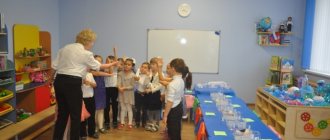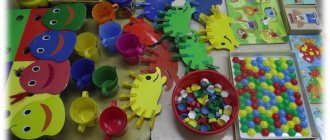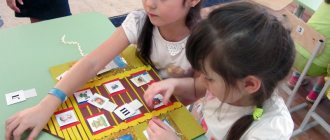DIDACTICAL GAMES ON THE BASICS OF LIFE SAFETY FOR OLDER CHILDREN.
Author: Entina Galina Vladimirovna
teacher of MKDOU d/s No. 29 Chelyabinsk region Yemanzhelinsky district, Zauralsky village
DIDACTICAL GAMES ON THE BASICS OF LIFE SAFETY FOR OLDER CHILDREN.
DIDACTICAL GAMES ON THE BASICS OF LIFE SAFETY
FOR 4 - 5 AGES
Section: “Child at home”
- didactic game: “Let’s get to know each other”
Target:
develop the ability to say your first and last name, age. Develop the ability to name your parents' names. Instill love for loved ones.
Progress of the game:
The teacher says that an “interesting character” (some kind of toy) came to visit the children in the group and wants to get to know the children better. Children sit in a circle, and an interesting character is passed on in turn. When the object is in the hands of the child, he must say his first name, last name, age, and the names of his parents.
- didactic game: “In the world of dangerous things”
Target:
continue to introduce children to objects that may be dangerous to life and health, but which are necessary for humans. Warn against possible accidents at home.
Progress of the game:
The teacher demonstrates household items. Children clap on safe objects and stomp if the object could cause harm
- didactic game: “Don’t play with fire”
Target:
introduce the dangers posed by fire.
Progress of the game:
The teacher tells the children that “Sparkle” has come to visit them. She wants to play with them. The teacher shows cards where Sparkle will be “good” (stove, stove, torch) or “bad” (fire, bonfire without supervision). Children must determine the purpose of "Sparkle"
- didactic game: “What do we know about things”
Target:
expand children’s understanding of the rules of safe behavior at home; develop attention and memory; foster a sense of cooperation.
Material:
four game cards depicting a cut, burn, hand bruise and fire; pictures depicting various household items.
Progress of the game:
4 children take part in the game, each of them takes a game card with the image of an “injury”. The teacher (child) is the leader. He picks up a picture of an object one by one. Participants must guess what injury could result from improper handling of this item, match it to their card and take the picture. When selecting, the child must explain why this or that object is dangerous and tell the rules for handling it.
- didactic game: “I’m not afraid of needles”
Target:
strengthen the ability to safely handle a needle; develop fine motor skills; cultivate attention and perseverance.
Material:
needles and threads attached to the base of the box; buttons.
Progress of the game
: invite children to assemble a “pyramid” of buttons by stringing them on a needle and thread, or to collect beads by threading a needle and thread into both button holes.
- didactic game:
“1,2,3, find what could be dangerous”
Target:
strengthening the idea of sources of danger in the house, developing intelligence and attention.
Material:
layout or game corner with household items, prizes
Progress of the game:
The presenter turns away and counts to 3-5, and during this time the children must take from the model or in the play corner those objects that, in their opinion, may be dangerous, then everyone explains their choice. Answers are rewarded with prizes.
Section: “Child and Nature”
Target:
formation of ideas that contact with animals can be dangerous.
Material:
pictures (models of animals) depicting animals in a period of rest and in a period of aggression, cards in red and green colors.
Description:
Look carefully at the pictures (models of animals), put a green card on the picture that shows an animal that you can now approach (rest period). And a red card goes to a picture of an animal during a period of aggression (you cannot approach). For the blind, we select animals: to the right is possible, to the left is dangerous.
- 2
.
didactic game: “Nature is our home”
Target:
teach respect for nature, flora and fauna.
Material:
cards with the image of a broken tree, a fire, garbage in the forest.
Progress of the game:
The teacher shows pictures on the topic, the task of the children is to divide them into 2 groups, what can be done and what cannot be done.
- 3
.
didactic game:
“
Our helpers are plants”
Target:
to strengthen children's ideas about how to help themselves and others always stay healthy.
Equipment
: subject pictures depicting medicinal plants.
Description:
The game is played on the lotto principle. Children have cards with images of medicinal plants. The teacher shows pictures with similar drawings. A child who has this plant talks about its use for healing. If he said it correctly, he gets a picture. The one who closes his card first wins.
- didactic game:
“Choose edible mushrooms and berries”
Target:
consolidation of knowledge about edible and poisonous plants, the ability to distinguish them from each other.
Material:
baskets, dummies or cards depicting edible and poisonous mushrooms and berries, chips.
Description:
offer to collect edible mushrooms and berries in baskets, and leave the “inedible” ones in the forest. For each correctly chosen plant, a chip. The player with the most chips wins.
Section: “Child on the street”
- 1. didactic game: “Traffic light”
Goal: to introduce children to traffic lights, explain the meaning of each color, teach children the rules of behavior when crossing the street.
Material
: cards yellow, red and green.
Progress of the game:
Children are divided into pedestrians and traffic lights. The traffic lights light up one by one, and the children's task is to imitate pedestrians' reaction to each traffic light signal.
- didactic game: “What would you do”
Target:
strengthening the ability to make the right decisions in various life situations, to control one’s behavior when communicating with people.
Material:
story pictures on the problem, prizes.
Description:
players consider illustrated typical dangerous situations of possible contacts with strangers on the street:
- an unfamiliar adult persuades a child to go somewhere with him, promising to show him something interesting, offering a toy;
- an unfamiliar adult opens the car door and invites you to ride with him;
- an unfamiliar adult treats you to candy, ice cream, etc.
For each correct decision, the player receives a prize.
- didactic game: “Put a road sign”
Target:
teach children to distinguish road signs (warning - “Children”, “Pedestrian crossing”, “Wild animals”, prohibiting - “Entry is prohibited”, “Traffic is prohibited”, “Bicycles are prohibited”, prescriptive - “Move straight”, “Traffic”) to the right”, “Move to the left”, information and signposts - “Parking place”, “Pedestrian crossing”, service signs - “First aid station”, “Telephone”, “Food station”, “Gas station”, “Car maintenance” ", "Resting place", "Traffic police post"); develop attention and spatial orientation skills.
Material
: road signs, playing field depicting roads, pedestrian crossings, railway crossings, administrative and residential buildings, parking lots, intersections.
Progress of the game:
children are offered:
- Consider the playing field and what is depicted on it.
- Place the necessary road signs. For example, at a school there is a sign “Children”, at a cafe - “Food station”, at an intersection - “Pedestrian crossing”, etc.
The winner is the one who manages to place all the signs correctly and quickly within a certain time.
Section: “Child and health”
- didactic game: "Ambulance"
Target:
strengthening children's knowledge and practical skills in first aid.
Material:
pictures, medical supplies (thermometer, syringe, cotton wool, etc.)
Progress of the game:
The teacher plays out with the children a situation where a person has cut his arm, leg, broken his knee, elbow, has a fever, has a sore throat, has a speck of dirt in his eye, and has a nose bleed. For each situation, a sequence of actions is worked out.
- didactic game:
“How to dress so as not to get sick.”
Target:
fix the names of clothes and the order of dressing
Material:
doll and doll clothes
Progress of the game:
It is necessary to dress the Masha doll according to the weather; the weather conditions are chosen by the presenter or teacher.
Junior group
We offer games on the theme “Dangerous Objects” for younger preschoolers.
Dangerous household items
The game is a lotto. For it you need to prepare a table with cells depicting dangerous things, as well as corresponding cards.
The teacher reads a poem or riddle about the subject. The students, having guessed what this thing is, choose a card and cover the picture in the table cell with it.
Green or red
For this lesson you need to prepare two large circles: green and red. It is also necessary to cut out small circles depicting dangerous and safe things.
The teacher lays out the pictures in front of the players. They carefully examine the images, discuss the purpose and degree of danger of the drawn objects. Then they arrange the pictures around large circles, like petals around the core of a flower. Objects that are dangerous are placed in the red circle, and items that are completely safe to use are placed in the green circle.
Dangers
The game reinforces the idea of what dangers a preschooler can face in everyday life, how to deal with them, and how to act correctly. The activity also teaches empathy and fosters a desire to help people in trouble. It is necessary to prepare plot pictures depicting various dangerous situations that can happen to a preschooler at home, in the yard, or in nature.
The teacher places the pictures face down. Pupils take turns taking a card at random, look at the depicted plot, tell what they see, why such a situation happened to the child, what he did wrong, how to correct the mistake, how to act.
Behavioral game “Dos and Don’ts”
Alena Kalashnikova
Behavioral game “Dos and Don’ts”
Game “
Dos and Don’ts ” The favorite word of children at any age is “give” or “I want”, they don’t think about what is not allowed , in order for children to understand you can conduct a behavioral game .
Goal: to introduce children to the diversity of needs and disabilities . Learn to determine what is possible and what is not.
Rules: determine which concept is “ possible ”
or
“
not allowed ” refers to the object depicted on the cardboard, and glue the picture onto the corresponding panel.
The pictures are associated with the rules of behavior in various situations: at the table, on the street, in transport, in society, and so on.
Material: Pictures with positive and negative behavior , as well as a board where these pictures are attached.
“We cannot forget these roads” 70 years of Victory The holiday is held with preliminary preparation of children. literary and musical composition dedicated to May 9” for older preschoolers.
Consultation “Relationship between children and adults: do’s and don’ts” Not everything in life works out the way we would like, and sometimes circumstances turn out to be stronger than us. In moments of failure, we want to.
“This is my Motherland - it cannot be divided.” Photo report on May 9, Victory Day is a holiday, It’s fireworks in the evening. There are many flags at the parade, People sing joyfully! Veterans with orders Remember the war and talk.
Art therapy in correctional work with preschoolers (behavioral and emotional-volitional spheres) “Art therapy” (art (English) - art, therapeia (Greek) - care, treatment) is understood as care for psychological and emotional health.
Didactic game on life safety “What is possible, what is not” mmDidactic game on life safety “What is possible, what is not” Preschool age is the most important period when formation. Safety game "Do's and Don'ts" Unfortunately, many accidents happen at home. Our house is filled to capacity with various household appliances and chemicals. My task is...
Consultation for parents “Discipline: do’s and don’ts” Consultation for parents. Discipline: “dos” and “don’ts.” Prepared by Olesya Anatolyevna Manik, teacher of Kindergarten No. 17, Krasnodar.
What not to talk about in front of children. What not to talk about in front of children. Have you ever paid attention to how your child behaves when you communicate with other adults?
Outline of a correctional lesson for older preschoolers using multi-therapy “Dos and Don’ts” Topic of the lesson: “Dos and Don’ts” Goal: correction of negative behavioral manifestations when prohibitions arise Tasks: 1. Formation of awareness.
Project “We can’t live without water” PROJECT: “We can’t live without water” Age: 2-3 years Author: Maltseva Lyubov Petrovna. Relevance: Foster an environmental culture.
Source




